HONDA CR-V 2014 RM1, RM3, RM4 / 4.G Owners Manual
Manufacturer: HONDA, Model Year: 2014, Model line: CR-V, Model: HONDA CR-V 2014 RM1, RM3, RM4 / 4.GPages: 365, PDF Size: 18.39 MB
Page 341 of 365
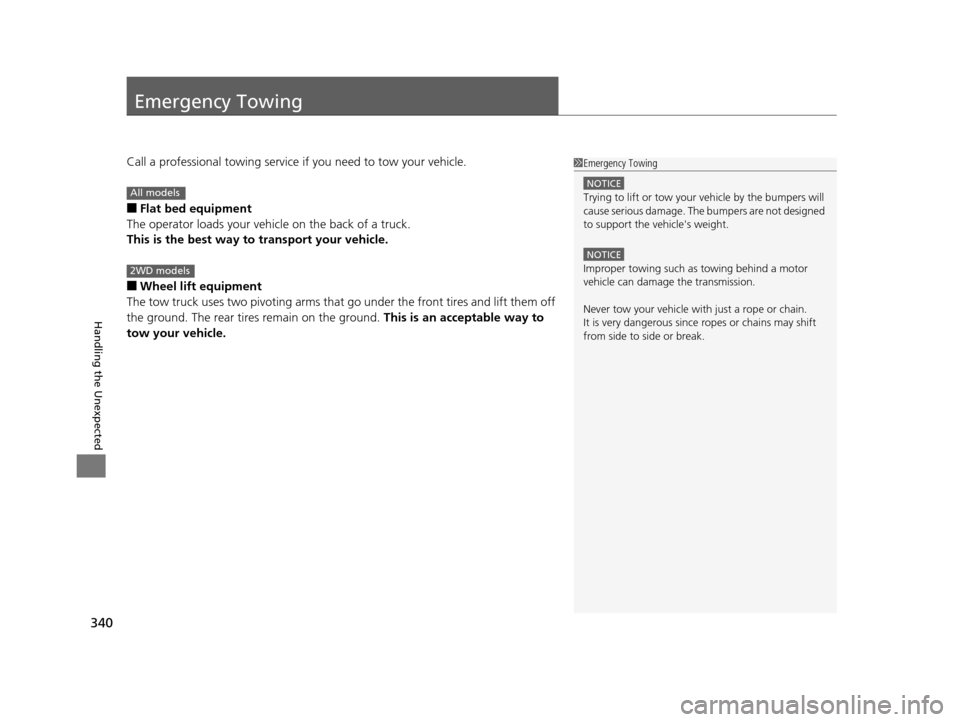
340
Handling the Unexpected
Emergency Towing
Call a professional towing service if you need to tow your vehicle.
■Flat bed equipment
The operator loads your vehicle on the back of a truck.
This is the best way to transport your vehicle.
■Wheel lift equipment
The tow truck uses two pivoti ng arms that go under the front tires and lift them off
the ground. The rear tires remain on the ground. This is an acceptable way to
tow your vehicle.
1 Emergency Towing
NOTICE
Trying to lift or tow your vehicle by the bumpers will
cause serious damage. The bumpers are not designed
to support the vehicle's weight.
NOTICE
Improper towing such as towing behind a motor
vehicle can damage the transmission.
Never tow your vehicle with just a rope or chain.
It is very dangerous since ropes or chains may shift
from side to side or break.
All models
2WD models
14 CR-V-31T0A6200.book 340 ページ 2014年2月10日 月曜日 午後7時1分
Page 342 of 365
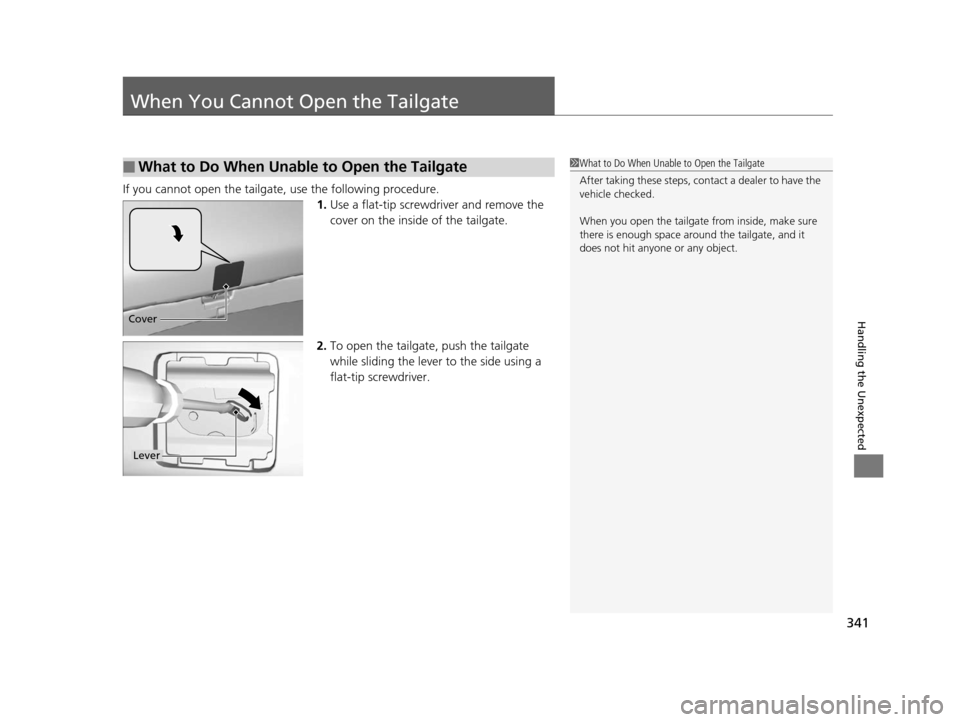
341
Handling the Unexpected
When You Cannot Open the Tailgate
If you cannot open the tailgate, use the following procedure.1.Use a flat-tip screwdriver and remove the
cover on the inside of the tailgate.
2. To open the tailgate, push the tailgate
while sliding the lever to the side using a
flat-tip screwdriver.
■What to Do When Unable to Open the Tailgate1What to Do When Unable to Open the Tailgate
After taking these steps, cont act a dealer to have the
vehicle checked.
When you open the tailgate from inside, make sure
there is enough space around the tailgate, and it
does not hit anyone or any object.
Cover
Lever
14 CR-V-31T0A6200.book 341 ページ 2014年2月10日 月曜日 午後7時1分
Page 343 of 365

342
14 CR-V-31T0A6200.book 342 ページ 2014年2月10日 月曜日 午後7時1分
Page 344 of 365
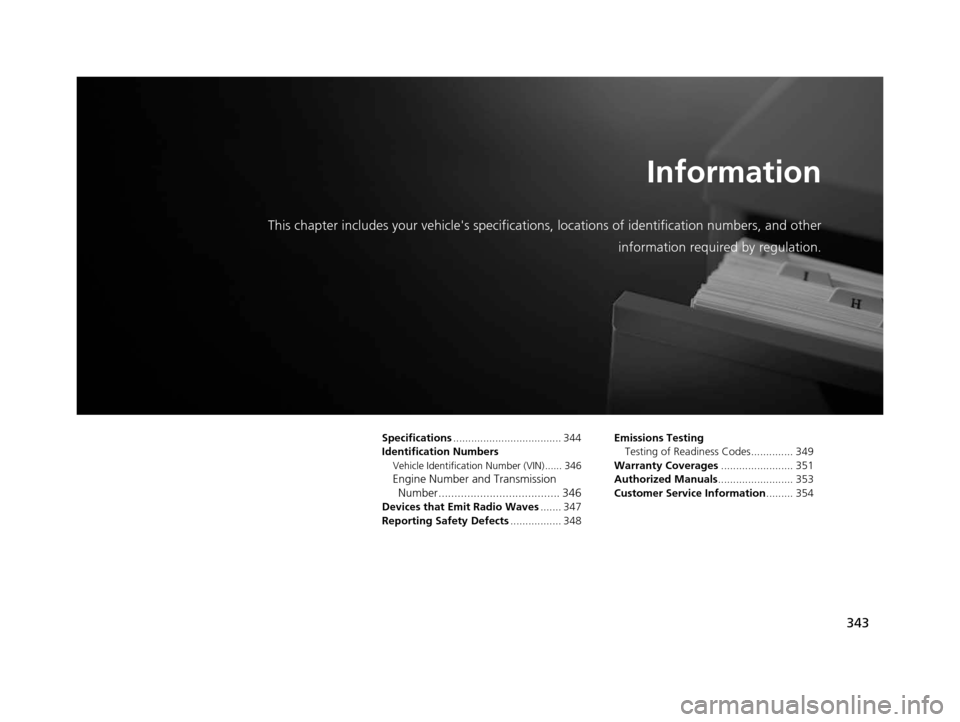
343
Information
This chapter includes your vehicle's specifications, locations of identification numbers, and other
information required by regulation.
Specifications .................................... 344
Identification Numbers
Vehicle Identification Number (VIN)...... 346
Engine Number and Transmission Number...................................... 346
Devices that Emit Radio Waves ....... 347
Reporting Safety Defects ................. 348Emissions Testing
Testing of Readiness Codes.............. 349
Warranty Coverages ........................ 351
Authorized Manuals ......................... 353
Customer Service Information ......... 354
14 CR-V-31T0A6200.book 343 ページ 2014年2月10日 月曜日 午後7時1分
Page 345 of 365
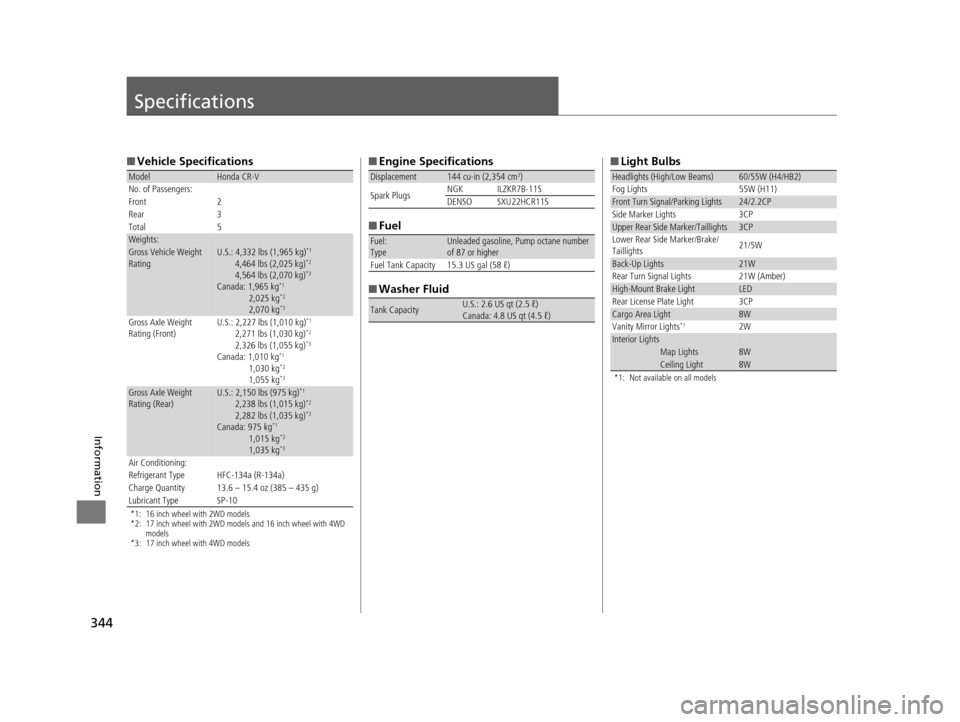
344
Information
Specifications
■Vehicle Specifications
*1: 16 inch wheel with 2WD models
*2: 17 inch wheel with 2WD models and 16 inch wheel with 4WD
models
*3: 17 inch wheel with 4WD models
ModelHonda CR-V
No. of Passengers:
Front 2
Rear 3
Total 5
Weights:Gross Vehicle Weight
Rating U.S.: 4,332 lbs (1,965 kg)*1
4,464 lbs (2,025 kg)*2
4,564 lbs (2,070 kg)*3
Canada: 1,965 kg*1
2,025 kg*2
2,070 kg*3
Gross Axle Weight
Rating (Front)U.S.: 2,227 lbs (1,010 kg)*1
2,271 lbs (1,030 kg)*2
2,326 lbs (1,055 kg)*3
Canada: 1,010 kg*1
1,030 kg*2
1,055 kg*3
Gross Axle Weight
Rating (Rear)U.S.: 2,150 lbs (975 kg)*1
2,238 lbs (1,015 kg)*2
2,282 lbs (1,035 kg)*3
Canada: 975 kg*1
1,015 kg*2
1,035 kg*3
Air Conditioning:Refrigerant Type HFC-134a (R-134a)Charge Quantity13.6 – 15.4 oz (385 – 435 g)Lubricant TypeSP-10
■ Engine Specifications
■ Fuel
■ Washer Fluid
Displacement144 cu-in (2,354 cm3)
Spark Plugs NGK ILZKR7B-11S
DENSO SXU22HCR11S
Fuel:
TypeUnleaded gasoline, Pump octane number
of 87 or higher
Fuel Tank Capacity 15.3 US gal (58 ℓ)
Tank CapacityU.S.: 2.6 US qt (2.5 ℓ)
Canada: 4.8 US qt (4.5 ℓ)
■ Light Bulbs
*1: Not available on all models
Headlights (High/Low Beams)60/55W (H4/HB2)
Fog Lights 55W (H11)
Front Turn Signal/Parking Lights24/2.2CP
Side Marker Lights 3CP
Upper Rear Side Marker/Taillights3CP
Lower Rear Side Marker/Brake/
Taillights 21/5W
Back-Up Lights21W
Rear Turn Signal Lights 21W (Amber)
High-Mount Brake LightLED
Rear License Plate Light 3CP
Cargo Area Light8W
Vanity Mirror Lights*12WInterior LightsMap Lights8WCeiling Light8W
14 CR-V-31T0A6200.book 344 ページ 2014年2月10日 月曜日 午後7時1分
Page 346 of 365
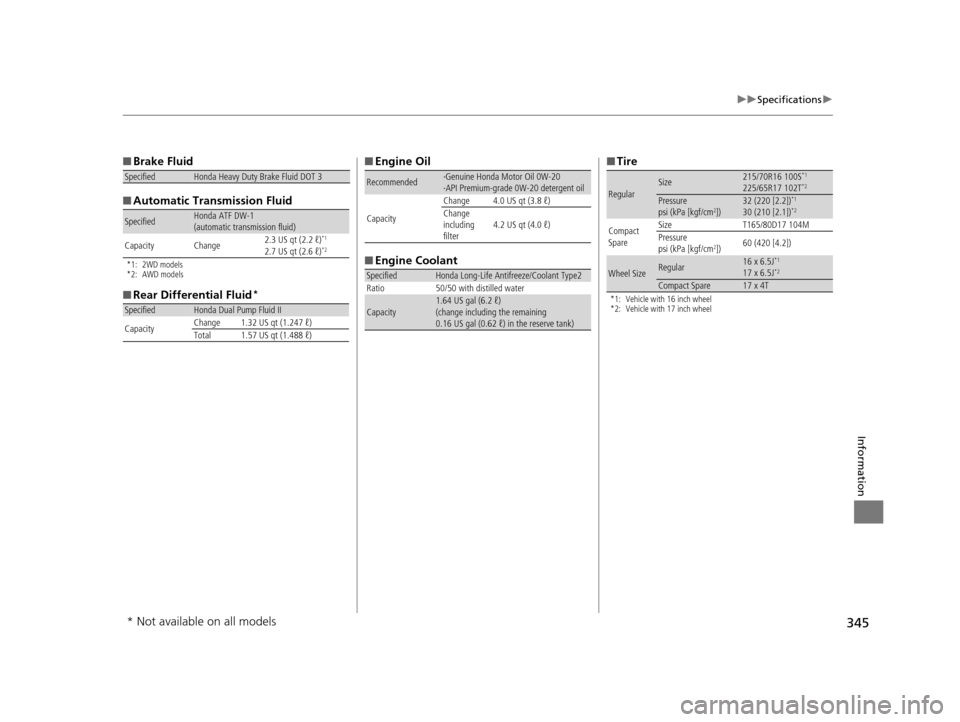
345
uuSpecifications u
Information
■Brake Fluid
■ Automatic Transmission Fluid
*1: 2WD models
*2: AWD models
■Rear Differential Fluid*
SpecifiedHonda Heavy Duty Brake Fluid DOT 3
SpecifiedHonda ATF DW-1
(automatic transmission fluid)
Capacity Change 2.3 US qt (2.2 ℓ)
*1
2.7 US qt (2.6 ℓ)*2
SpecifiedHonda Dual Pump Fluid II
Capacity Change 1.32 US qt (1.247 ℓ)
Total 1.57 US qt (1.488 ℓ)
■
Engine Oil
■ Engine Coolant
Recommended·Genuine Honda Motor Oil 0W-20
·API Premium-grade 0W-20 detergent oil
Capacity Change 4.0 US qt (3.8 ℓ)
Change
including
filter
4.2 US qt (4.0 ℓ)
SpecifiedHonda Long-Life Antifreeze/Coolant Type2
Ratio 50/50 with distilled water
Capacity1.64 US gal (6.2 ℓ)
(change including the remaining
0.16 US gal (0.62 ℓ) in the reserve tank)
■ Tire
*1: Vehicle with 16 inch wheel
*2: Vehicle with 17 inch wheel
RegularSize215/70R16 100S*1
225/65R17 102T*2
Pressure
psi (kPa [kgf/cm2])32 (220 [2.2])*1
30 (210 [2.1])*2
Compact
Spare Size
T165/80D17 104M
Pressure
psi (kPa [kgf/cm
2]) 60 (420 [4.2])
Wheel SizeRegular16 x 6.5J*1
17 x 6.5J*2
Compact Spare17 x 4T
* Not available on all models
14 CR-V-31T0A6200.book 345 ページ 2014年2月10日 月曜日 午後7時1分
Page 347 of 365
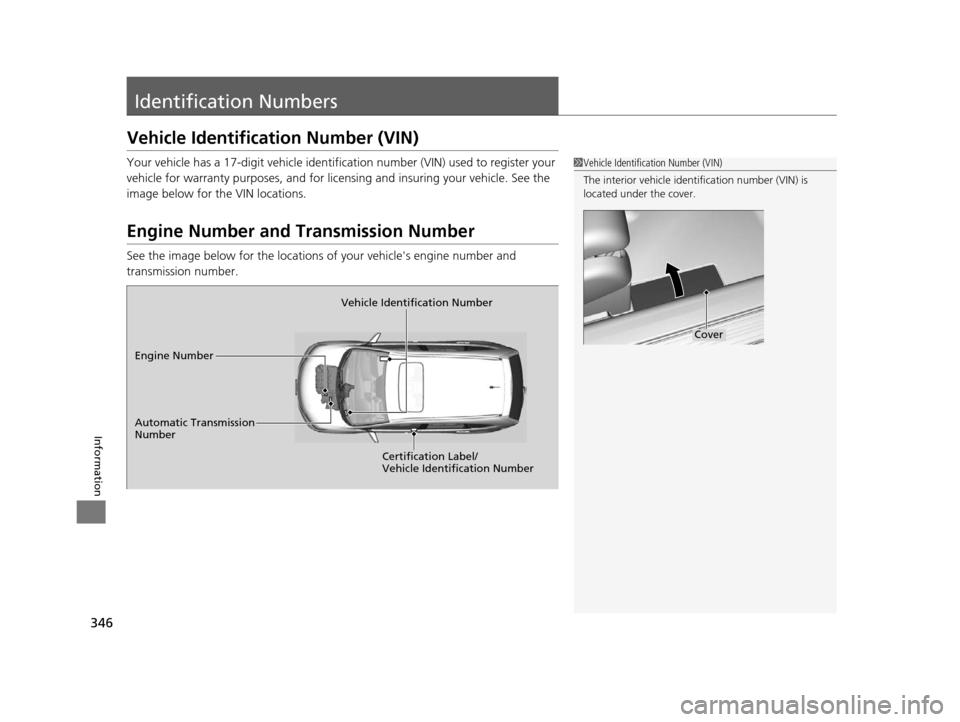
346
Information
Identification Numbers
Vehicle Identification Number (VIN)
Your vehicle has a 17-digit vehicle identification number (VIN) used to register your
vehicle for warranty purposes, and for licen sing and insuring your vehicle. See the
image below for the VIN locations.
Engine Number and Transmission Number
See the image below for the locations of your vehicle's engine number and
transmission number.
1 Vehicle Identification Number (VIN)
The interior vehicle identification number (VIN) is
located under the cover.
Cover
Vehicle Identification Number
Engine Number
Certification Label/
Vehicle Identification Number
Automatic Transmission
Number
14 CR-V-31T0A6200.book 346 ページ 2014年2月10日 月曜日 午後7時1分
Page 348 of 365
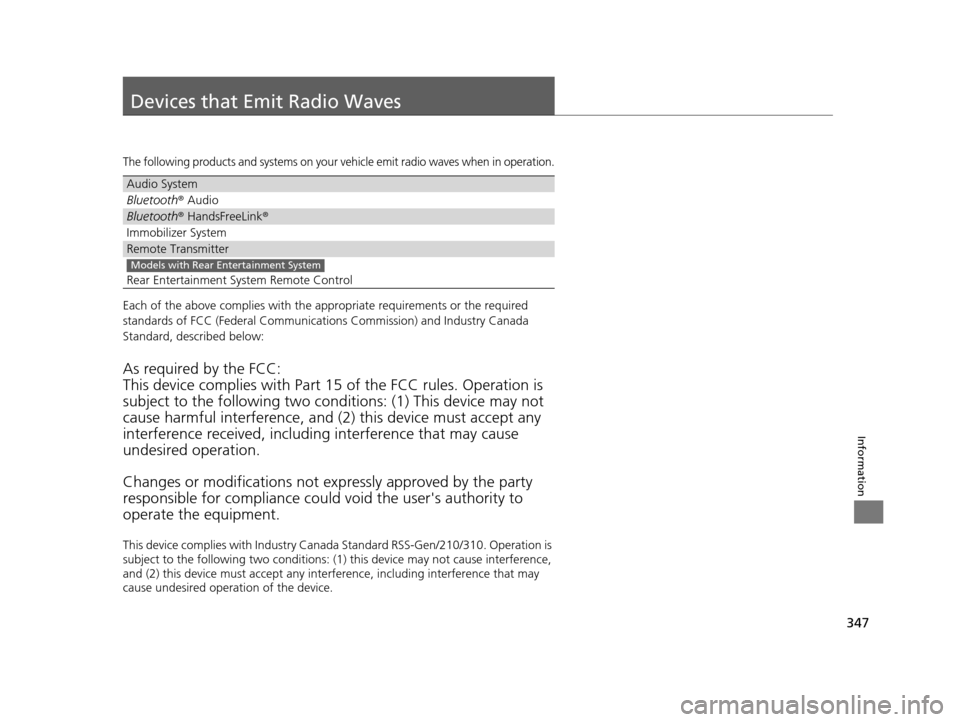
347
Information
Devices that Emit Radio Waves
The following products and systems on your vehicle emit radio waves when in operation.
Each of the above complies with the appropriate requirements or the required
standards of FCC (Federal Communications Commission) and Industry Canada
Standard, described below:
As required by the FCC:
This device complies with Part 15 of the FCC rules. Operation is
subject to the following two cond itions: (1) This device may not
cause harmful interferenc e, and (2) this device must accept any
interference received, including interference that may cause
undesired operation.
Changes or modifications not ex pressly approved by the party
responsible for compliance could void the user's authority to
operate the equipment.
This device complies with Industry Canada Standard RSS-Gen/210/310. Operation is
subject to the following two conditions: (1) this device may not cause interference,
and (2) this device must accept any inte rference, including interference that may
cause undesired operation of the device.
Audio System
Bluetooth ® Audio
Bluetooth® HandsFreeLink ®
Immobilizer System
Remote Transmitter
Rear Entertainment System Remote Control
Models with Rear Entertainment System
14 CR-V-31T0A6200.book 347 ページ 2014年2月10日 月曜日 午後7時1分
Page 349 of 365
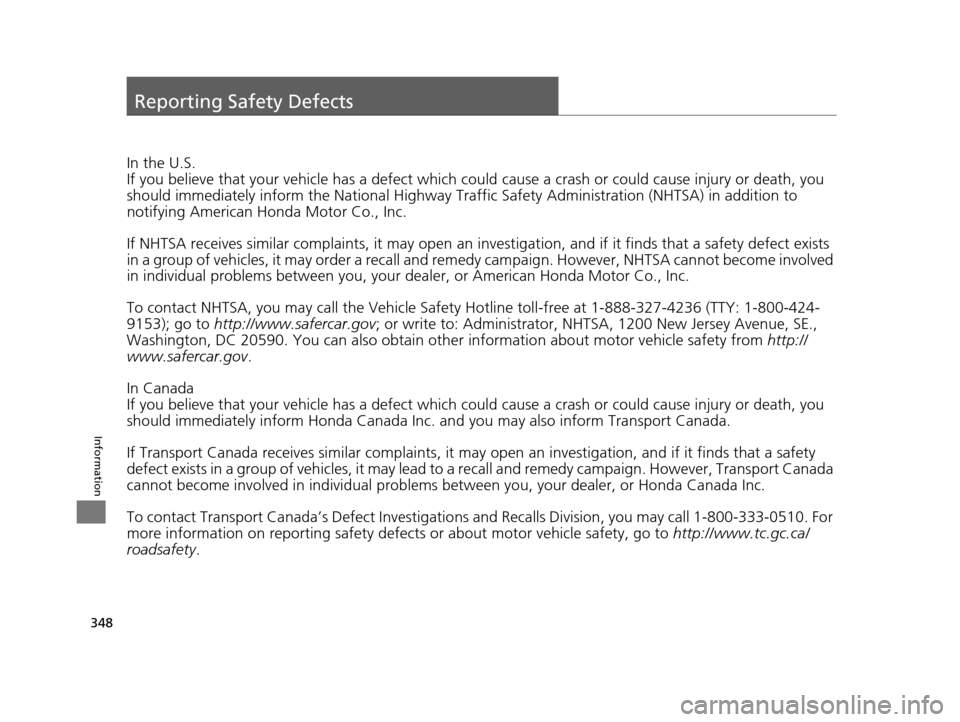
348
Information
Reporting Safety Defects
In the U.S.
If you believe that your vehicle has a defect which could cause a crash or could cause injury or death, you
should immediately inform the Nati onal Highway Traffic Safety Administration (NHTSA) in addition to
notifying American Honda Motor Co., Inc.
If NHTSA receives similar complaints, it may open an inve stigation, and if it finds that a safety defect exists
in a group of vehicles, it may order a recall and remedy campaign. However, NHTSA cannot become involved
in individual problems between you, your dealer, or American Honda Motor Co., Inc.
To contact NHTSA, you may call the Vehicle Safety Ho tline toll-free at 1-888-327-4236 (TTY: 1-800-424-
9153); go to http://www.safercar.gov ; or write to: Administrator, NHTSA , 1200 New Jersey Avenue, SE.,
Washington, DC 20590. You can also obtain othe r information about motor vehicle safety from http://
www.safercar.gov .
In Canada
If you believe that your vehicle has a defect which c ould cause a crash or could cause injury or death, you
should immediately inform Honda Canada Inc. and you may also inform Transport Canada.
If Transport Canada receives similar complaints, it may open an investigation, and if it finds that a safety
defect exists in a group of vehicles, it may lead to a recall and remedy campaign. However, Transport Canada
cannot become involved in individual problems between you, your dealer, or Honda Canada Inc.
To contact Transport Canada’s Defect Investigations and Recalls Division, you may call 1-800-333-0510. For
more information on reporting safety defects or about motor vehicle safety, go to http://www.tc.gc.ca/
roadsafety .
14 CR-V-31T0A6200.book 348 ページ 2014年2月10日 月曜日 午後7時1分
Page 350 of 365
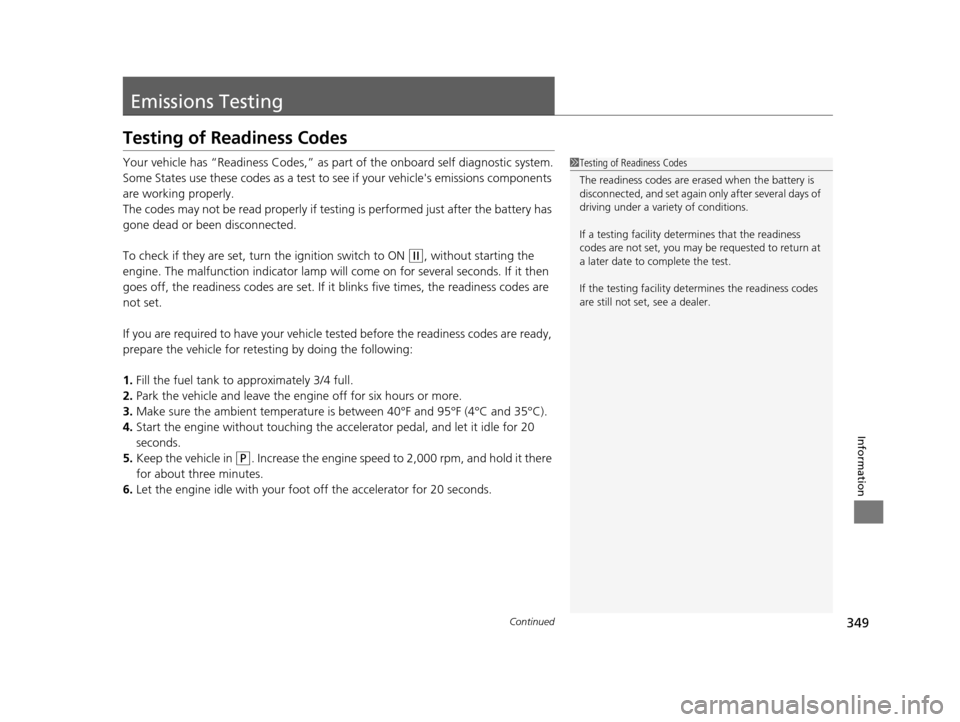
349Continued
Information
Emissions Testing
Testing of Readiness Codes
Your vehicle has “Readiness Codes,” as part of the onboard self diagnostic system.
Some States use these codes as a test to see if your vehicle's emissions components
are working properly.
The codes may not be read properly if testing is performed just after the battery has
gone dead or been disconnected.
To check if they are set, tu rn the ignition switch to ON
(w, without starting the
engine. The malfunction indicator lamp will co me on for several seconds. If it then
goes off, the readiness codes are set. If it blinks five times, the readiness codes are
not set.
If you are required to have your vehicle te sted before the readiness codes are ready,
prepare the vehicle for retest ing by doing the following:
1. Fill the fuel tank to approximately 3/4 full.
2. Park the vehicle and leave the engi ne off for six hours or more.
3. Make sure the ambient temperature is between 40°F and 95°F (4°C and 35°C).
4. Start the engine without touching the ac celerator pedal, and let it idle for 20
seconds.
5. Keep the vehicle in
(P. Increase the engine speed to 2,000 rpm, and hold it there
for about three minutes.
6. Let the engine idle with your foot off the accelerator for 20 seconds.
1Testing of Readiness Codes
The readiness codes are erased when the battery is
disconnected, and set again onl y after several days of
driving under a variety of conditions.
If a testing facility determines that the readiness
codes are not set, you may be requested to return at
a later date to complete the test.
If the testing facility determines the readiness codes
are still not set, see a dealer.
14 CR-V-31T0A6200.book 349 ページ 2014年2月10日 月曜日 午後7時1分